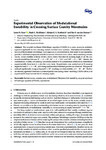Experimental Observation of Modulational Instability in Crossing Surface Gravity Wavetrains
| dc.contributor.author | Steer, JN | |
| dc.contributor.author | McAllister, ML | |
| dc.contributor.author | Borthwick, AGL | |
| dc.contributor.author | van den Bremer, TS | |
| dc.date.accessioned | 2021-08-22T15:29:23Z | |
| dc.date.available | 2021-08-22T15:29:23Z | |
| dc.date.issued | 2019 | |
| dc.identifier.issn | 2311-5521 | |
| dc.identifier.issn | 2311-5521 | |
| dc.identifier.other | ARTN 105 | |
| dc.identifier.uri | http://hdl.handle.net/10026.1/17681 | |
| dc.description.abstract |
<jats:p>The coupled nonlinear Schrödinger equation (CNLSE) is a wave envelope evolution equation applicable to two crossing, narrow-banded wave systems. Modulational instability (MI), a feature of the nonlinear Schrödinger wave equation, is characterized (to first order) by an exponential growth of sideband components and the formation of distinct wave pulses, often containing extreme waves. Linear stability analysis of the CNLSE shows the effect of crossing angle, θ , on MI, and reveals instabilities between 0 ∘ < θ < 35 ∘ , 46 ∘ < θ < 143 ∘ , and 145 ∘ < θ < 180 ∘ . Herein, the modulational stability of crossing wavetrains seeded with symmetrical sidebands is determined experimentally from tests in a circular wave basin. Experiments were carried out at 12 crossing angles between 0 ∘ ≤ θ ≤ 88 ∘ , and strong unidirectional sideband growth was observed. This growth reduced significantly at angles beyond θ ≈ 20 ∘ , reaching complete stability at θ = 30–40 ∘ . We find satisfactory agreement between numerical predictions (using a time-marching CNLSE solver) and experimental measurements for all crossing angles.</jats:p> | |
| dc.format.extent | 105-105 | |
| dc.language | en | |
| dc.language.iso | en | |
| dc.publisher | MDPI AG | |
| dc.subject | surface waves | |
| dc.subject | crossing seas | |
| dc.subject | modulational | |
| dc.subject | Benjamin-Feir instability | |
| dc.subject | coupled nonlinear Schrodinger equation (CNLSE) | |
| dc.subject | experiments | |
| dc.title | Experimental Observation of Modulational Instability in Crossing Surface Gravity Wavetrains | |
| dc.type | journal-article | |
| dc.type | Article | |
| plymouth.issue | 2 | |
| plymouth.volume | 4 | |
| plymouth.publication-status | Published online | |
| plymouth.journal | Fluids | |
| dc.identifier.doi | 10.3390/fluids4020105 | |
| plymouth.organisational-group | /Plymouth | |
| plymouth.organisational-group | /Plymouth/Faculty of Science and Engineering | |
| plymouth.organisational-group | /Plymouth/Faculty of Science and Engineering/School of Engineering, Computing and Mathematics | |
| plymouth.organisational-group | /Plymouth/Users by role | |
| plymouth.organisational-group | /Plymouth/Users by role/Academics | |
| dc.identifier.eissn | 2311-5521 | |
| dc.rights.embargoperiod | Not known | |
| rioxxterms.versionofrecord | 10.3390/fluids4020105 | |
| rioxxterms.licenseref.uri | http://www.rioxx.net/licenses/all-rights-reserved | |
| rioxxterms.type | Journal Article/Review |


